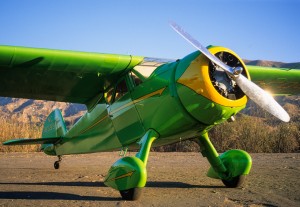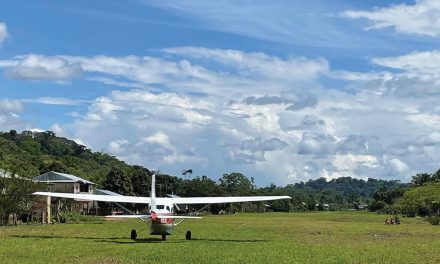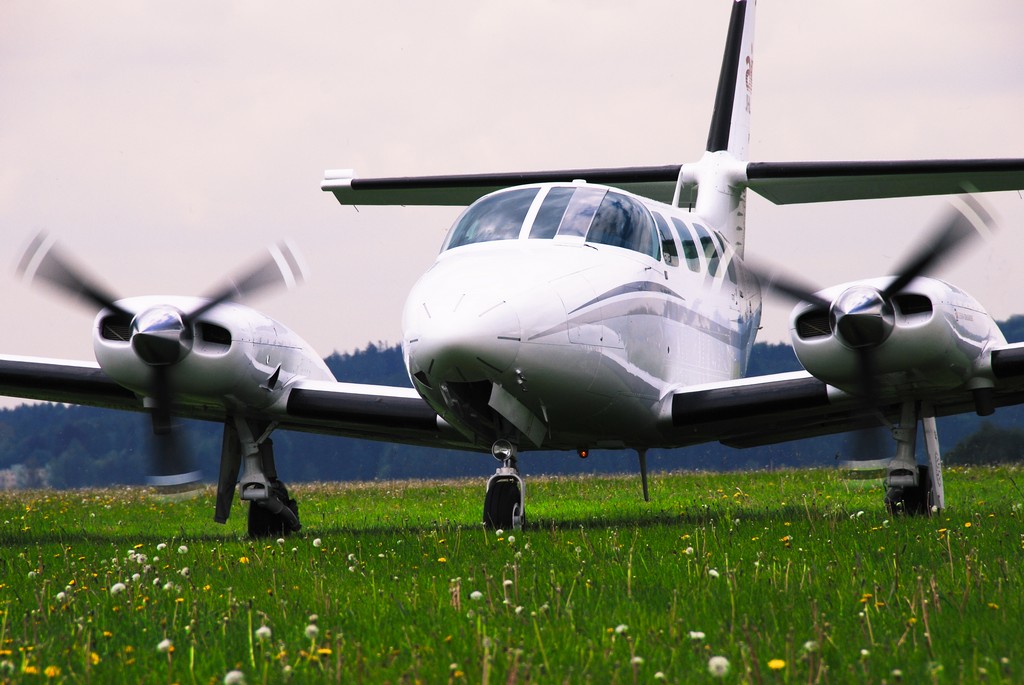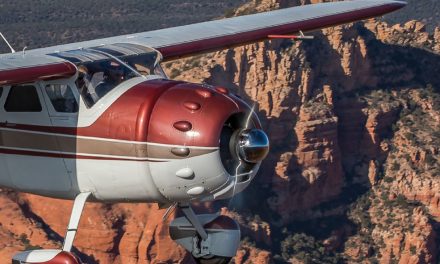 Pre-war or post-war, the Airmaster refused to be ignored
Pre-war or post-war, the Airmaster refused to be ignored
There’s something about round engines. I know, I know, there are hardly any left these days. In fact, here in the U.S., the only example still in production is the Waco YMF-5, a revival of those famous Wacos of yesteryear. Still, you have to love round-engine airplanes. They present a classic contour to the sky, a shape that has pretty much disappeared except for a few handfuls of antiques.
There were very few radial-powered, high-performance machines – the Staggerwing, the Spartan Executive, and maybe one or two more – so radials typically powered smaller aircraft. But back in the days when radials were the rage, it was enough that they made that endearing chug-a-putt sound.
Every year, tens of thousands of people go to Reno just to hear the deep-chested thunder of radial warbirds flying the pylons at nearly 500 mph. Bearcats and Sea Furies entertain everyone with their low-frequency roar, while the plethora of Mustangs rocket by with their Rolls Royce Merlins screaming at power settings far in excess of anything they used during WWII.
Cessna’s C37 Airmaster was significantly more sedate and laidback, but it was immediately recognizable as a member of the radial club. Created in the 1930s by aeronautical engineer and future Cessna president Dwayne Wallace (Clyde Cessna’s nephew), the Airmaster was Cessna’s savior following the stock market crash of 1929 and the resulting Great Depression.
The airplane was highly labor intensive to build, a factor which allowed Cessna to hire more assembly workers, but also limited the airplane’s future. Shortly after introduction of the original Airmaster, Mr. Cessna retired and left the company to Wallace, who remained its leader for the next 40 years.
The Airmaster was/is powered by a variety of radial mills, predominately Warner Scarabs, ranging from 145 to 175 hp. Scarabs are, of course, long since out of production, and accordingly, keeping one running can demand considerable detective skills. Dickerson Aircraft of Columbia, Missouri, is a clearing house for engine parts, but even they can be challenged to find everything you might need to rebuild a Warner radial.
The Airmaster utilized a fabric-covered, welded, tube steel fuselage, a full cantilever, Clark Y, high wing, and a narrow, short-coupled, conventional landing gear. Electrically-activated spilt flaps were mounted on the bottom fuselage. The wings themselves were constructed of wood and the whole machine was covered with heavily-doped fabric.
The Airmaster’s cabin is compact—and that’s being generous. Everyone enters through a door at the rear and climbs up to the front office. Pilot and copilot sit directly in front of the main spar carrythrough that runs along the rook, and the steep slope of the airplane’s attitude on the ground means the flight crew’s feet stick straight out in front of them. The cabin is narrow and not terribly comfortable, another common characteristic of airplanes of that era.
Starting a radial has always been one of the defining experiences of flying older airplanes. The little Warner may not be the guttural experience of firing up a Pratt 985, but it’s still a thrill when the Scarab comes to life and begins coughing black smoke out the stacks. The seven cylinders will belch and gag for a few cycles – as if they were voting on whether or not to run – but when they all catch and settle down, the Warner engine is smooth and reassuring.
If the engine hasn’t been run for a while, it’s almost guaranteed to blow oil out the stacks during start, so it’s best to warn lookey-loos not to stand behind it. Similarly, if you’re proud of your Airmaster and like to keep it clean, you’ll need a supply of rags to wipe it down after every flight.
Visibility from the left front is limited because of small side windows and a narrow windshield. There are no struts connecting the wings to the fuselage, so you don’t need to dodge your head to see around anything, but surface operation has its own challenges. Steering on the ground is with a non-steerable tailwheel, a seeming contradiction in terms. S-turns are absolutely mandatory if you care what you’re about to hit, as there’s essentially no view straight ahead over the high cowling. There is a tailwheel lock, so once you’re in position on the runway for takeoff with the airplane pointed straight down the centerline and the third wheel in perfect trail, you can lock it and depart with little deviation. There is some steering with the tailwheel locked, but only a few degrees.
It’s more than coincidence that the larger, post-war Cessna 195 Businessliner has a strong family resemblance to the earlier model—sort of an Airmaster with a hormone injection. The radial engine on the 195 was stepped up to a more powerful Jacobs mill and cabin size was increased.
For its part, the C165 flew behind an Aeromatic propeller, typically a black, Micarta, two-blade, that automatically adjusted its pitch in flight, a clever idea – when it worked. Redline for takeoff was 2340 rpm, allowable for one minute. After that, you needed to reduce power to 2200 rpm.
Climb was an alleged 1000 fpm—mostly alleged and more often 700-800 fpm. The Airmaster manifested reasonable, if not enthusiastic, control harmony. At max cruise settings and 6000 feet MSL, the result was about 125-130 knots cruise, not that bad for only 165 hp. Contrast that with a standard Archer or Skyhawk that flies behind 180 hp and cruises at 128-133 knots.
To be honest, the Airmaster isn’t exactly a great flying airplane, but the radial engine and classic lines make up for some of its deficiencies. Elevator trim is mandatory for any pitch or configuration change, especially at low speeds. Roll and pitch response are commanded by a conventional joystick. Turns are casual, at best, and the fastest control is (predictably) the elevator.
As you might expect, the Airmaster manifests considerable adverse yaw, so you need to lead most maneuvers with rudder rather than aileron to properly coordinate any change in direction.
Proper coordination of aileron and rudder become especially important during/at the bottom of the envelope. Stalls can seem benign if you’re in the habit of keeping the ball centered. Unfortunately, even those of us who learned to fly in predominately adverse yaw airplanes have often long forgotten those lessons. Under normal circumstances, the Airmaster exhibits a gentle buffet before falling pretty much straight through. That’s with the ball somewhere near the center. Try such uncoordinated silliness with the ball well out of its cage, and you’ll wind up pointed straight downhill in a spin fairly abruptly. In fairness, such dramatics demand significant abuse, but the Airmaster will do things you’d never see on newer Cessnas.
Specific fuel consumption is fairly immutable, no matter what the age of the aircraft, so the three fuel tanks – 17.5 left and right, plus 10 gallons in a fuselage aux container for a total of 45 gallons – provide about 4.5 hours of endurance plus reserve. The aux tank is mounted on the ceiling directly behind the wing spar carrythrough, which in turn, is directly behind the pilot and copilot’s head. (Apparently, crashworthiness wasn’t much of a concern in the 1930s.)
The center tank drains into the left main, making that tank effectively contain 27.5 gallons. For that reason, you’ll be flying on the left tank most of the time to avoid a fuel imbalance.
In yet another bow to the electrical engineering of the 1930s (or lack of same), the fuel gauges are capacitance style. Capacity normally reads a disconcerting zero on each tank. To check quantity, you push a button under the appropriate tank, and a needle slowly rises to its theoretically accurate indication. Release the button until it falls to zero; then, you can check the other fuel source indications.
The Airmaster likes a final approach speed of about 60 knots, and there’s nothing that exotic about the landing if you’ve flown old-style taildraggers before. The flaps have a limit speed of 80 knots, and if you make the mistake of trying to deploy flaps too early, the airplane will remind you by simply refusing to extend the spoilers. The electric motor is small and simply not up to the task of dropping flaps into any higher air loads.
Flaps are all drag and no lift, so you’ll see a notable change in the airplane’s attitude when the flaps are fully deployed. Full flap slips are fun if you need to come downhill in a hurry. Just be careful to start the round out soon enough to avoid sinking right through the flare.
Three-point landings seem to be favored, just as with most other classic generation taildraggers. The airplane can be urged into a military Ker plunk attitude if need be, and that attitude will practically assure no bounce. Some pilots favor the two-point wheel landing, though it’s important to remember to nail the main wheels to the runway with slight forward stick after touchdown, as by definition, the airplane won’t be fully stalled in the wheel attitude.
Braking is with the same atrocious, hydraulic heel brakes used on the J-3 Cub, almost universally hated by every pilot who flew with them. The airplane I flew for this report had the original brakes, but many owners of the few remaining Airmasters have converted their airplanes to toe brakes. Heel brakes are inconvenient when your feet are already practically straight out in front of you. By definition, you must push with your heels while moving your toes back, a trick even Barishnikov would envy. It’s not an impossible trick for most people, but it is one more reason why no one likes heel brakes.
Like so many other airplanes in the era of the ‘30s, the Airmaster was a work in progress. It offered reasonable performance and acceptable comfort, but systems were primitive, handling was little better than marginal, and flying it demanded significantly more care and attention than might be expected of a modern general aviation single. That’s called evolution.
Specifications & Performance – Cessna C-37 Airmaster
One reliable source of information is Jane’s All-the-World’s Aircraft. Specifications on older aircraft will not always agree as several sources may disagree on performance.
Specifications
Engine(s)- make/model: Warner Scarab 7 cylinder radial
Hp: 165
Fuel type: 80 octane
Landing gear type: Conventional
Max TO weight (lbs): 2350
Empty weight (lbs): 1380
Useful load–std (lbs): 970
Usable fuel–std (gal/lbs): 45/270
Payload–full std fuel (lbs): 700
Wingspan: 34’ 2”
Overall length: 24’ 8”
Height: 7’ 9”
Power loading (lbs/hp): 14.2
Cabin doors: 1
Performance
Cruise speed (kts–75%): 130
Cruise Fuel Burn (gph/lbs): 8.2 (@ .40/lbs/hp/hr sfc)
Best rate of climb, SL (fpm): 1000
Stall (Vso – kts): 48 (est)





